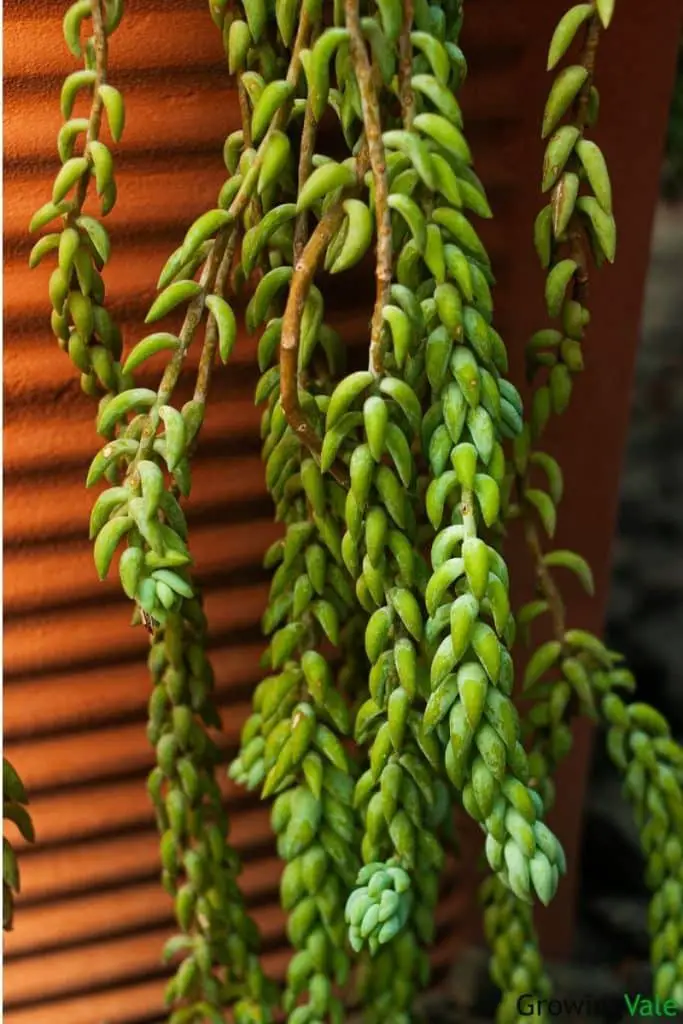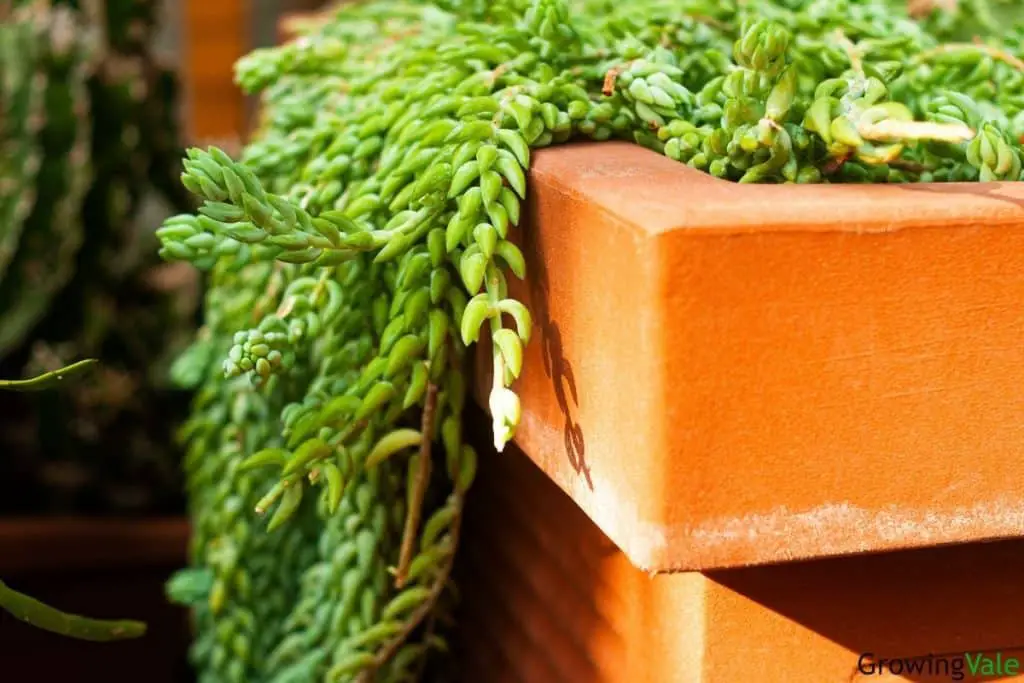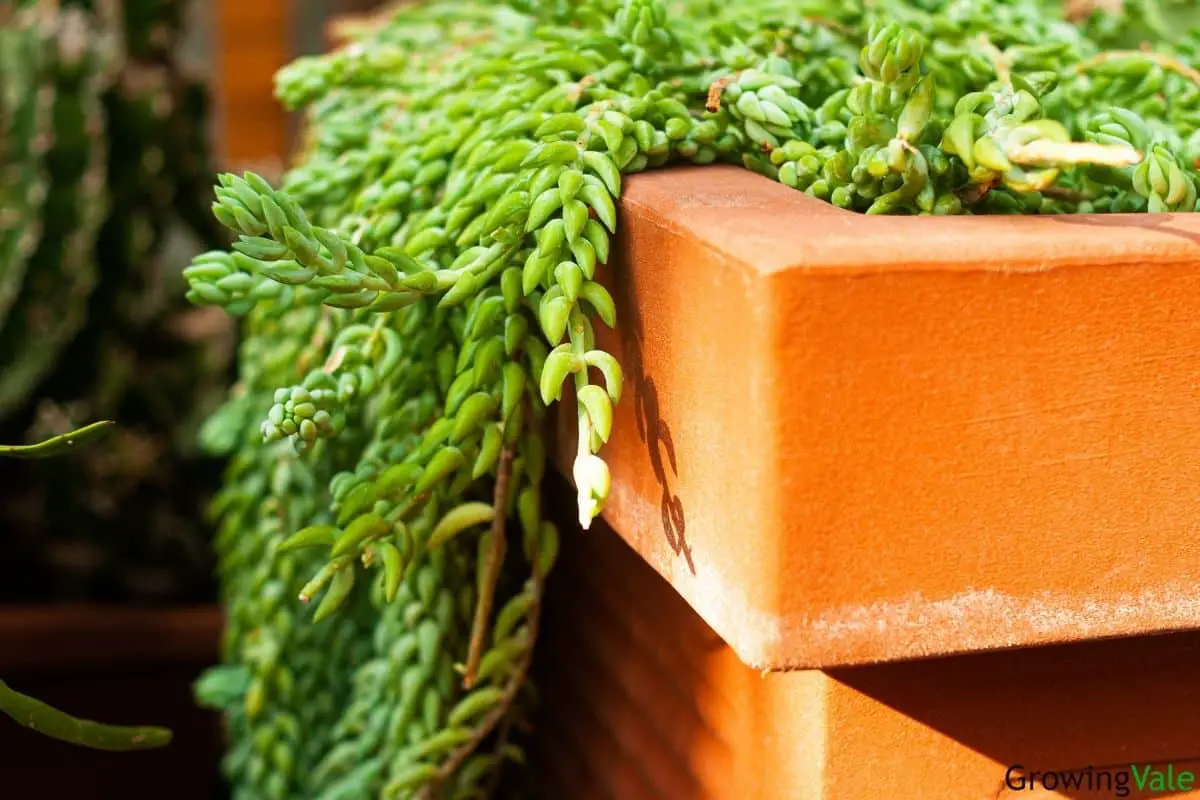Burro’s tail is an easy succulent to grow as a pot plant. Ideally, it grows well in a hanging planter or basket so that the long stems can trail down over the edges of the planter. Alternatively, you could put it in a nice decorative pot that you place on a plant stand or pedestal, near a window.
Burro’s tail grows long stems that are tightly packed with small green leaves. From a distance, the stems look like they’ve been plaited. Bear in mind that the leaves are a little fragile and can break off easily if the plant is handled excessively.
If you live in a temperate zone without winter frosts, you can even grow this plant outdoors. It would make a nice ground cover for your rock garden. The plant can tolerate full morning sun but does not like wet feet so the spot you choose should be well-drained.
If grown outdoors, you might see that your Burro’s tail is covered with white chalky wax. This is perfectly normal and is known as epicuticular wax. This wax helps the plant leaves retain moisture and protects the plant from the hot sun.
History
Burro’s tail was first discovered by botanist Eric Walther in Mexico in 1935 in a small nursery in Coatepec. After discovering this plant, he brought some back with him to California where it was cultivated.
For many years, there was mystery around the actual native origins of this plant. Then, in 2008, two Mexican botanists, David Jimeno-Sevilla and Amparo Alvalat-Botana, visited the ranch, Rancho Bellreguard de Sochiapa. Ranch owner, Carlos Ros, took the botanists to a spot where he had seen Sedum morganianum growing.
When they arrived at the spot, they did indeed spot the plant growing in the rock crevices of some vertical cliffs. They brought back some specimens and it was confirmed that the plant was Sedum morganianum.
Plant Facts
| Scientific name | Sedum morganianum |
| Common names | Burro’s tail, donkey’s tail, lamb’s tail, monkey tail, horse’s tail |
| Genus | Sedum |
| Family | Crassulaceae |
| Height | Each stem can grow to a length of 2 feet |
| Width | It will only grow as wide as the pot will accommodate. When used as a ground cover, it will spread as far as is possible. |
| USDA Plant Hardiness Zone | 9 to 11 |
| Origin | Southern Mexico & Honduras |
| Flower colors | Red, white or yellow |
| Blooming season | Summer |
| Plant/Flower special features | This plant rarely blooms when grown indoors |
How to Plant and Grow Burro’s Tail
Sedum morganianum is an easy succulent to grow if you leave it alone. In fact, this is one plant that definitely thrives on neglect. This is because the tiny leaves will fall off the stems with just the slightest touch.
Therefore, once you’ve planted it in its pot and hung the pot where the plant gets plenty of light but is protected from the wind, it’s best just to leave it alone and admire it from afar.

How to Propagate Burro’s Tail
Sedum morganianum is fairly easy to propagate using just the leaves. As these leaves tend to fall off easily if the plant is disturbed, you’re going to have plenty of propagating material from this plant.
It’s best to use a soilless medium when propagating this plant. You could use a succulent or cactus mix. All you have to do is gather the fallen leaves and push them partway into the mix.
Keep the mix moist using a spray bottle until the plants start to produce some roots.
You can also propagate this plant from stem cuttings. To do this, cut off a few pieces of stem and remove the lower leaves. Leave the stems out to dry and callus. Once calluses have formed on the stem end, you can place the cuttings in a succulent mix to grow roots.
Donkey’s Tail Plant Care and Maintenance
Donkey’s tail succulents require very little maintenance. Make sure your plant gets at least 4 hours of bright light every day and only water when the potting mix is dry. Fertilize during the warmer months.
Try not to disturb your plant too often so that it doesn’t lose too many of its leaves. Here are some specific donkey tail succulent care tips:
Soil
If you’re growing your donkey tail succulent in a pot, then you should use a cactus or succulent mix. These mixes are specially made to allow excess water to drain away.
If you want to grow your plant outside, then you need to choose a spot with extremely well-drained sandy soil. Planting on a slope is good if you’re going to use the plant as a ground cover. Alternatively, you could find some large garden rocks and create a crevice between them that you fill with cactus mix and plant your succulent into this.
Water
Donkey tail plants like to dry out in between watering and generally, you should only have to water the plant once a fortnight or when the soil is completely dry.
When it’s time to water, soak the soil thoroughly and make sure you let all of the excess water drain away. This part is really important for healthy succulents like Burro’s tail. Never ever let your plant sit in a saucer of water. This will cause the roots to rot and kill your plant.
In the winter, the plant is dormant so you should not have to water very often. Keep an eye on your plant and if you see some of the leaves start to shrivel, then it’s time to give it a good soak.
Fertilizer
Sedum morganianum should be fed with a liquid fertilizer regularly once a month from spring to fall. This will encourage the plant to put on lots of new growth.
In winter, the plant goes dormant and doesn’t require any feeding.

Sunlight
Sedum morganianum can be grown in full sun or part shade. If you’ve just brought your succulent home from the nursery or garden center, make sure you acclimatize it to full sun in stages if you plan to grow it in a sunny spot outside.
If growing inside, choose a nice bright spot near a window that doesn’t let direct sunlight in. This plant prefers at least 4 hours of bright light daily.
If you see your plant starting to get a bit leggy and the leaves are falling off excessively, it might mean that it’s not getting enough light. In this case, just prune back the leggy parts and move the pot to a brighter spot
Temperature and Humidity
Sedum morganianum prefers warmer temperatures and does not tolerate frost. Therefore, only people who live in USDA zones 9 – 11 can grow this plant outdoors all year round. Those in colder climatic zones should either grow Burro’s tail indoors or bring the plant in during the colder months.
Pruning
It’s not necessary to prune Burro’s tail. However, you can cut back any stems that have lost a lot of their leaves. Pruning also keeps your succulent more compact, if that is what you want.
Use any stems that you cut off to propagate new plants as these should root fairly readily.
Pest and diseases
The only pests that may attack your Sedum morganianum are mealybugs. These can be quite hard to find as they hide within the folds of the plant. If your plant is looking a little lackluster, it may have a mealybug problem.
To control this pest, simply spray your plant with an insecticidal soap solution or Neem oil. Remember to spray the potting mix as well.
As for diseases, root rot is the main problem that may affect your plant. Once your succulent suffers from root rot, there’s nothing you can do to save it. If this happens, just save the healthy leaves or stem section and use them to propagate new plants.
It’s far better to prevent root rot in the first place by ensuring that you never overwater your succulent and that it is growing in a well-draining mix.
Uses of Burro’s Tail Plant
Burro’s tail plant is mainly grown for its ornamental value. It’s an excellent specimen for hanging pots both indoors and out.
If you live in a warmer climate, burro’s tail can also be grown outdoors as a ground cover. The area that you plant it, needs to be fairly dry and have excellent drainage. Rock gardens are ideal.
Common Varieties and Cultivars
There are not many varieties or cultivars of burro’s tail except for the following:
- Baby donkey tail (Sedum burrito)
- Giant burro’s tail (Sedeveria ‘Harry Butterfield’)
However, there are many Sedum varieties you can grow.
Conclusion
Burro’s tail is an easy succulent to grow if you don’t handle it too much. It’s one of the best trailing succulents for hanging baskets as the long stems can trail down over the sides. However, the leaves do drop quite readily if the plant is disturbed, so it’s best to handle it as little as possible.
It only requires watering when the potting mix is completely dry and does benefit from some liquid fertilizer in the warmer months. The plant needs around four hours of bright light daily but should be protected from the scorching afternoon sun.
Burro’s tail succulent makes an attractive houseplant or it can be grown outdoors as a ground cover in areas with tropical or warm temperatures. However, this succulent does not tolerate frost, so should be brought indoors in areas that experience cold winters.
Also check more string of succulents you can grow.

